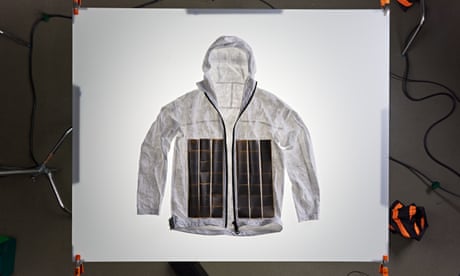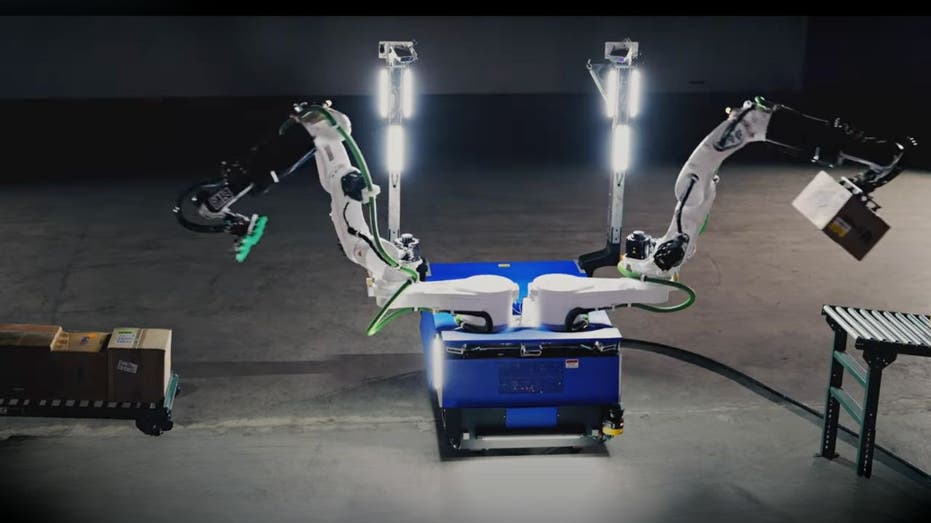- by foxnews
- 08 Apr 2025
What does a £100,000 ‘invisibility cloak’ look like? Funny you should ask …
What does a £100,000 ‘invisibility cloak’ look like? Funny you should ask …
- by theguardian
- 09 Nov 2022
- in technology

Harry Potter's invisibility cloak arrived in a parcel for Christmas, with a note from Dumbledore: "Use it well." Ron Weasley's reaction was, as you might expect, to be insanely jealous. Who, after all, hasn't dreamed of having the power of passing through the world without being seen?
Well, there might just be some good news for Ron and the rest of us. A pair of twins have created something very like an invisibility cloak. No, not the Weasley twins, but real-life brothers Steve and Nick Tidball. They call it the thermal camouflage jacket, and I've come to see it and Steve, in the offices of the brothers' futuristic clothing company, hidden away behind a Travelodge in King's Cross, London.
Their company is called Vollebak - which means something like "go all out" in Flemish - and their offices are how you would want a futuristic clothing company's to be: ping-pong table, piano (both brothers play), a bunch of people sitting around a honeycomb table looking into their laptops. Half of them are a team from a specialist manufacturer in Italy.
Steve shows me into a glassed-off meeting area and puts the jacket on. There is only one, and it's too small for me to try. It is white with dark grey vertical strips. Each one consists of 100 layers of graphene, the world's most conductive material, and one of the most expensive. The jacket cost roughly �100,000 to make, he says - there is a load of gold wiring in there as well. It has taken three years to get to this stage, working with Prof Coskun Kocabas (basically Prof Graphene) at the University of Manchester's National Graphene Institute.
OK, so I don't want to spoil the party or anything, but now I'm thinking less about Harry Potter and more about The Emperor's New Clothes, specifically the kid who pipes up. I need to be that kid: erm, Steve, I can see you and the jacket (actually it's like the opposite of The Emperor's New Clothes). You're right here, in front of me, not invisible.
"I am very far from invisible," he admits, before explaining that this is only the first step. The graphene patches can be programmed to mimic the radiation levels of their surroundings, at least in part of the spectrum, so that they effectively disappear in infrared light. "We wanted to demonstrate that in order to build an invisibility cloak you have to mix something soft - clothing - with something hard - optical devices. This is the first step in bringing hard and soft things together."
The key thing is that the graphene patches can be programmed individually, to emit different levels of thermal radiation, to blend in with the surroundings. The next step is to scale down the size of the patches, so that an object can blend into more complex surroundings - a person in a forest, say. Again, it's only in infrared light, but I'm thinking that if you don't want to be detected by one of those thermal imaging cameras police helicopters have, then a thermal camouflage jacket would be very handy.
Steve says he and his brother didn't think about uses, pointing out that when Benjamin Franklin witnessed an early hot air balloon flight in the 1770s and was asked what it was good for, he responded: "What good is a newborn baby?" They do things for fun, Steve says. "At some point I'm going to be on my deathbed and I'm going to think: what did I do? Did I have fun? We try to do ideas that we'll be proud of."
Steve and Nick used to work in advertising. And they ran ultramarathons; that is how it began, thinking about how running clothes could be improved. "The challenges we faced were: how do you sleep well the night before you're racing? If you're about to die of heat exhaustion, can your clothes help? If your head torch runs out in the middle of the night, can your clothes help? When you've finished racing through the Amazon, what do you do with your clothes if they're covered in faeces and ants?"
These challenges all led to products: a relaxation hoodie that zips up over your face (there are breathing holes), a range of incredibly lightweight clothes that dry really fast, a solar-charged jacket that can give off light when needed, and clothes made entirely from natural material that you can bury at the end of their life. "That sounds like we just went 'ping'," Steve says with a laugh. "It was a three-year, very elongated 'piiiiiiiiiiiiiiiing'."
Now they design clothes not so much for next season, more for next century. "It's a crazy time - of climate change, resource scarcity, disease spreading around the world, space colonisation," Steve says. "We look around and wonder why is no one else designing for this?"
He shows me some of their other stuff: the Apocalypse jacket, built to withstand lava, and the space-dust-proof Mars jacket, which has a 3D printed "vomit pocket" in case you get a bit queasy up there. Has Elon got one, I wonder. Either Steve doesn't know or he's not telling. But he says they would like to chat to Musk about some stuff and admits he is an inspiration. "Because he's looking into the future and designing solutions that he feels humanity is going to need in order to be able to survive."
Steve does words and business - he fizzes and bubbles with enthusiasm, like Willy Wonka. Nick is more intense - he is more about pictures and design. He's into materials, and making stuff that lasts for 100 years out of rubbish.
It all comes at a price, of course. The solar-charged jacket is �395, the Mars jacket �795.
The prices reflect the materials and methods they use, says Nick. "Pre the commercialisation of any new technology, it is inevitably expensive."
Anyway, Musk can afford a Mars jacket, if he wants one. Steve and Nick do drop a few names. Bear Grylls lives in his 100 Year hoodie (�395). It is fireproof, windproof, most probably bear-proof too. Brad Pitt's got a solar-charged jacket. Jack Dorsey, former CEO of Twitter, is a customer, as is Airbnb's Joe Gebbia, film director Christopher Nolan and artist Olafur Eliasson. "People who are also building the future in their field," says Steve. "When they buy, that's when we go: 'OK, we've nailed it.'"
Right now the clothes are for men, "just because of the economic challenges of making for men and women". The long-term aim is to make clothes for women too.
In the nearer future, I want an invisibility cloak for Christmas, like Harry Potter. They say the next step is to scale up the tech and scale down the graphene pixels, and the thermal camouflage jacket could be available to buy in the next five to 10 years. And we are still talking on the infrared spectrum, don't forget, so you are only going to be invisible to infrared cameras.
I want to go outside into King's Cross and hop on the Hogwarts Express, maybe, totally unseen. The Tidball twins say that by using graphene it should be possible ultimately to build a version that operates on the visible spectrum too.
Timescale? A bit longer. "If we come back in 1,000 years, has someone done it? Yes, I think they probably have," says Steve. There you are: put an invisibility cloak on your Christmas list for 3022.
- by foxnews
- descember 09, 2016
Ancient settlement reveals remains of 1,800-year-old dog, baffling experts: 'Preserved quite well'
Archaeologists have recently unearthed the remarkably well-preserved remains of a dog from ancient Rome, shedding light on the widespread practice of ritual sacrifice in antiquity.
read more





